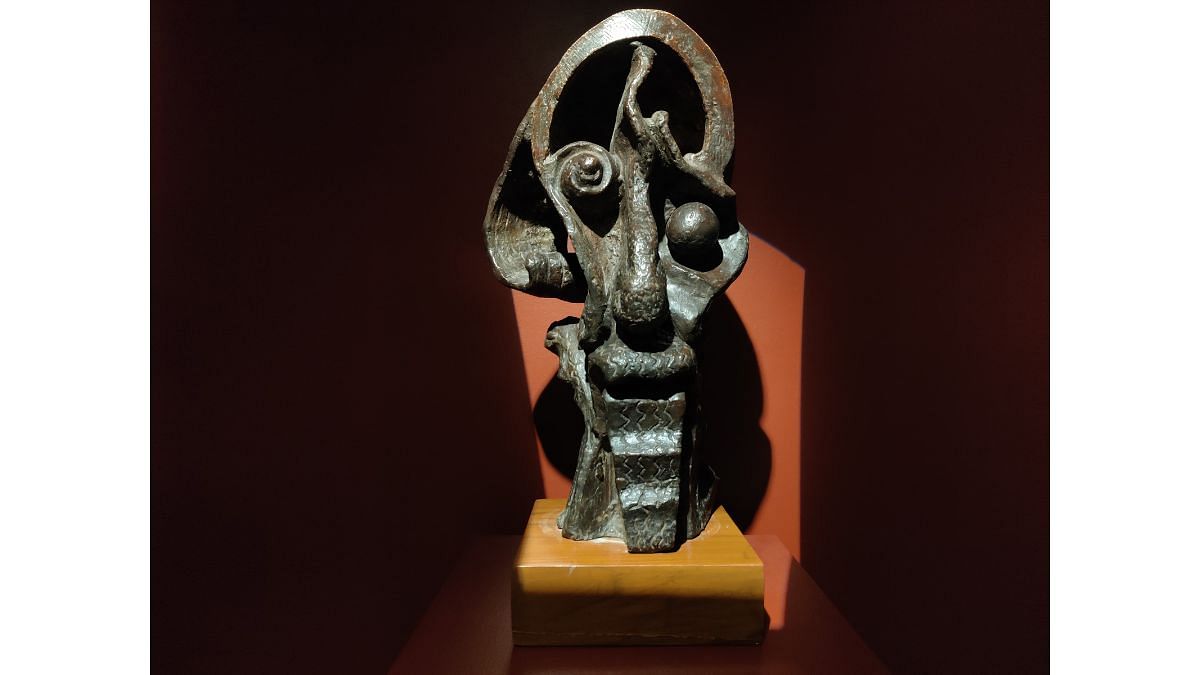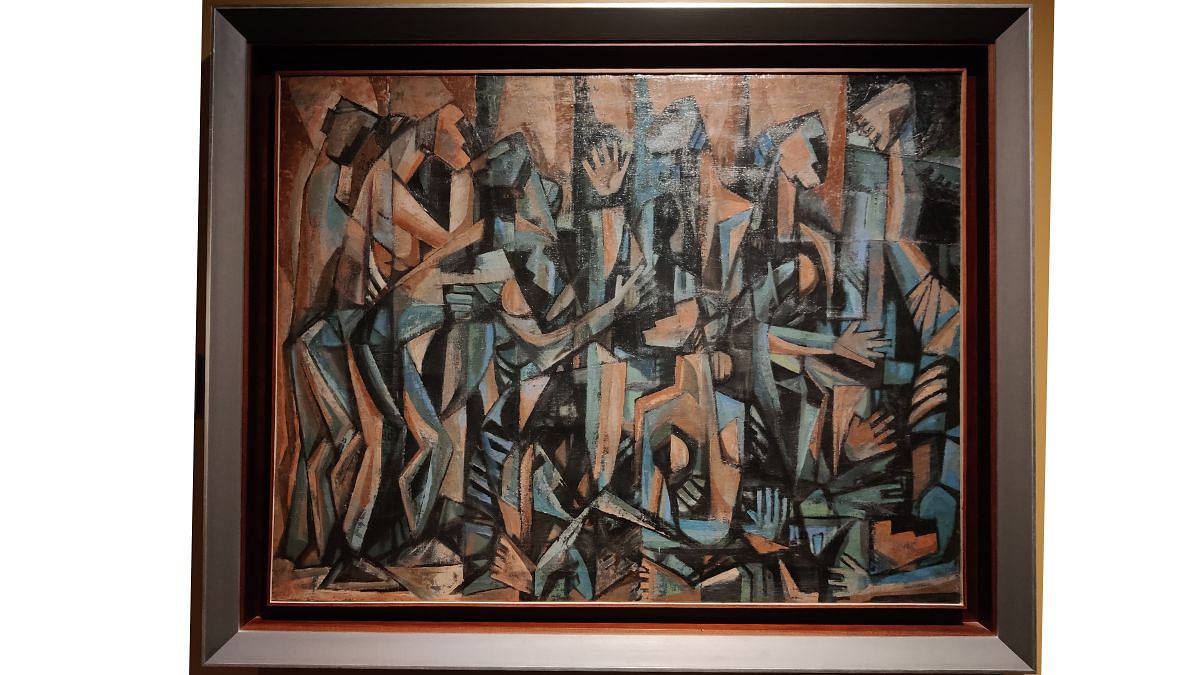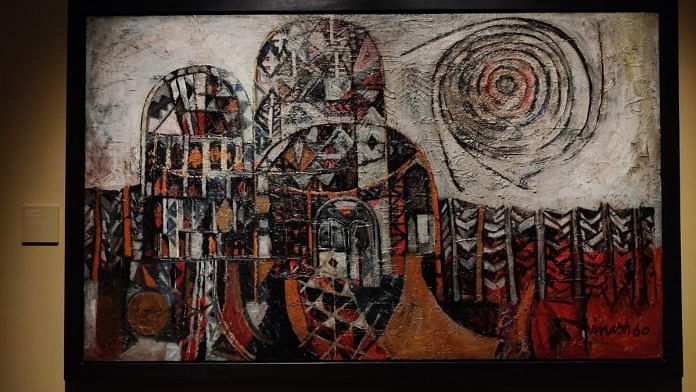New Delhi: In the dim glow of the gallery, Ramkinkar Baij’s sculpture of Rabindranath Tagore looms like a fractured echo of a troubled soul. Unlike the idealised portrayals of the poet-philosopher as a sage, Baij’s vision is raw—hollowed-out eyes, jagged edges, and a face sculpted with tension.
Its commanding presence belies its actual size—barely 12 inches in height—but it occupies pride of place at DAG Delhi’s latest exhibition, Deconstructed Realms: India’s Tryst with Cubism. The exhibition is going to last till 5 April. It takes visitors on an immersive journey through the evolution of Cubism in India.
Cast in cement, a radical material at the time, the piece shatters conventions, revealing a Tagore burdened by grief, loss, and the weight of his own ideals. More than just a sculpture, it’s a rupture in history—one that dared to see the man behind the legend.

“Tagore, towards the end of his life, was carrying the weight of so much—personal losses, financial struggles, and the immense responsibility of keeping his university alive. Baij captures that turmoil with an intensity that no other artist had dared to before. This man is haunted by his past, ambitions, and sacrifices. And that’s what makes this sculpture one of the most powerful creations of the 20th century,” said Kishore Singh, senior VP at DAG.
The exhibition explores how artists like Gaganendranath Tagore forged a unique Indian Cubist style and sculptors like Ramkinkar Baij extended the movement beyond the canvas into three-dimensional form. As India gained Independence, artists crossed borders—both physically and stylistically—engaging with global art movements, studying under European masters, and blending their influences with indigenous traditions.
Divided into four sections, the exhibition reclaims Cubism not as a borrowed movement but as a dynamic, evolving force in Indian modernism. Kaleidoscope of Change explores the origins of Cubism in India, while Crossing Borders highlights how post-Independence artists engaged with the rest of the world. Reflections of a New Nation examines how Cubism was used to depict India’s evolving socio-political landscape, blending modernist and indigenous themes. Finally, Abstracted Realities tracks the shift from figurative Cubism to pure abstraction, pushing the boundaries of form and expression.
“In India, aesthetics and beauty are inherent, rooted in tradition and literature. Our Cubism carries that lyricism, unlike the sharp, anxious edges of the West. We transform it into something poetic,” Singh told ThePrint.
“Look at our lines—the lyricism, the movement—their song and dance.”
The evolving language of art
Rabin Mondal’s Brothel is a song and dance of fractured figures, angular limbs, and reaching hands—a space of entrapment. The composition, a maze of overlapping forms, echoes the confined, inescapable reality of the women within. This painting, part of a larger series, carries echoes of Cubism’s origins. In 1907, Pablo Picasso shattered traditional realism with Les Demoiselles d’Avignon, a radical reimagining of prostitutes in a Spanish brothel.

Here, Mondal revisits that theme, but through a distinctly different lens—one that is not about the gaze of the viewer but the suffocating experience of the subjects. The artist transforms a place of commerce into one of confinement.
The women are pressed together, their bodies fragmented, their surroundings an oppressive jumble of shapes and shadows.
“Unlike Picasso’s depiction, which invites the viewer to look upon the women, Brothel engulfs them in a claustrophobic world, a space with no exit, where power and exploitation loom over every distorted form,” said Singh.
The exhibition buzzed with conversation as artists and enthusiasts gathered to witness the dialogue between modern audiences and timeless works. Visitors stood before paintings, murmuring interpretations, their voices weaving into the hum of the gallery. For some, it was more than an exhibit, it was a long-anticipated meeting ground, a mehfil where art became both the subject and the language of connection.
Also read: Bengaluru traffic police get an image makeover. A new museum shows them as heroes
Forms, spaces, and the sacred
In a quiet corner of the gallery, Emerging Idol, a painting stands in quiet contemplation, its muted tones drawing the viewer into a world both familiar and elusive. Hues of brown and blue whisper of age, of time-worn stone, of idols weathered by devotion. But this is not a temple sculpture. This is V Vishwanadhan’s vision, a bridge between the tangible and the ethereal.
“Most people will see this as just an abstract work and walk past it,” Singh said, standing before the piece. “But…there’s a sense of sacredness in it, the way he has structured it, the way the figure emerges, you begin to see more than just shapes. You see devotion, ritual, memory.”
The act of deciphering becomes an act of reverence, much like stepping into a temple where shadows and flickering lamps slowly reveal the divine.
Though distinct in style and subject, Vishwanadhan’s quiet contemplation of sacred forms and Avinash Chandra’s restless energy of shifting architecture share a common thread—both artists capture transformation. One distills devotion into abstraction, the other dissolves structure into movement. In their own ways, they blur boundaries between the physical and the metaphysical, inviting the viewer to see beyond the surface to witness art in a state of becoming.
Chandra’s painting feels like a city in motion, with grand arches, stained glass windows, and swirling patterns merging into one. It captures both the outside and the inside of the architecture of a church at once, as if the artist is trying to show the whole experience of a place rather than just its walls.
After moving from New Delhi to London, Chandra was fascinated by the city’s churches and towering buildings. Here, he paints not just their structure but their spirit, the way light filters through windows, the way spaces feel sacred yet alive.
“Look at the arches, the stained glass, the rigid forms. But then, look again. Faces start to appear. The buildings seem to shift. He’s already moving beyond architecture, reaching for something more,” said Singh.
The buildings begin to dissolve. Chandra was at a turning point in his work—moving from painting cityscapes to capturing the people within them.
“Art in India dates back to the Indus Valley civilisation. We’ve constantly adapted, changed, and assimilated but never stopped. Art isn’t just creation; it’s an artist capturing change, metamorphosis, and society in a moment,” said Singh.
(Edited by Ratan Priya)






